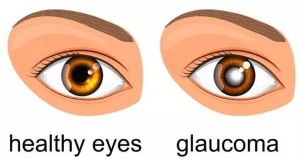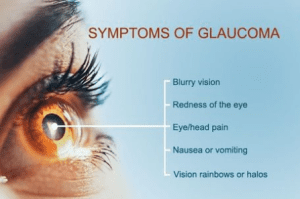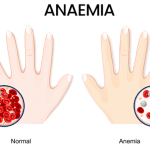Glaucoma is a disease of the optic nerve of the eye. There is no cure for glaucoma blindness; Prevention is the only way. Glaucoma is the second leading cause of blindness in the world. Around 80 million people worldwide are blind.

The number of glaucoma blind people is about 8 million. According to WHO globally, 1 billion people have a vision impairment that could have been prevented or has yet to be addressed. A large part of glaucoma patients is in South Asia. Lack of awareness about glaucoma causes a large population to suffer from irreversible blindness; which can be prevented if diagnosed at an early stage.
What Is Glaucoma?
Our eyes make a fluid that nourishes the tissues. Usually, this fluid flows through a channel called the drainage angle. When this channel does not work properly, fluids get stuck in the flow and begin to strain our eyes.
This puts a lot of pressure on the optic nerve which can damage the optic nerve. The optic nerve sends signals from our eyes to the brain. The brain converts the signals into images that we see. When the optic nerve does not work properly, vision problems begin. There may even be a risk of complete loss of sight. This condition is called glaucoma.

Also Read – Pneumonia: Symptoms of Pneumonia, Causes, Treatment and More you Need to Know
Those Who Are at Higher Risk of Glaucoma:
If your parents, siblings, or other family member have glaucoma, you are more likely to have it. There are also things that can cause glaucoma, that is:
- If you are over 40 years old
- If you have had an eye injury or an operation
- If you have diabetes, high blood pressure, or heart problems.
- If you have a problem with your optic nerve.
- If you have used steroid eye drops or pills.
Doctors are not sure if glaucoma can be prevented. However, regular eye exams can identify glaucoma.
Types of Glaucoma:
There are four common types of glaucoma. The most common is open-angle glaucoma
Open-Angle Glaucoma:
90% of people with glaucoma have open-angle glaucoma. This is called open-angle because it has a clear gap in the drainage channel inside which the fluid created by the eye is trapped. It is very slow. At first, you may not feel any symptoms.
Angle-Closure Glaucoma:
It is very fast and you have to go to the doctor immediately. This is usually the case for those whose drainage channels are completely closed and slightly empty. Due to a small gap in the drainage channel, the pressure inside the eye begins to increase rapidly and a small amount of fluid begins to flow out of the eye.
If you have severe pain in your eyes, headache, nausea, or difficulty seeing with your eyes, contact a doctor immediately. The doctor will open the front of your drainage channel through surgery. If you do not go to the doctor quickly, you may lose your eyesight.
Also Read – Ketogenic Diet: A Detailed Beginner’s Guide to Keto Diet
Normal-Tension Glaucoma:
If you have this type of glaucoma, then your eyes do not get more pressure than usual. Yet it can damage your optic nerve. Doctors are not sure why this happens. If you go to the doctor, the doctor will treat you to reduce the pressure of your eyes to normal.
Congenital glaucoma:
It is extremely rare and usually occurs in young children. This problem occurs if the drainage channel does not develop properly during pregnancy. When this happens the baby’s eyes become blurred and the eyes look bigger than normal. This problem can be fixed by surgery. Most of the time if it is treated quickly, normal vision lasts a lifetime.
Glaucoma Causes:
Although no specific cause of this disease has been found, high blood pressure is still considered to be the main cause of Glaucoma. However, the disease also can occur if your blood pressure is normal. Usually the high pressure in the eye which slowly damages the nerves in the eye and impairs vision.
However, there is a deep connection between some diseases with Glaucoma and also can be due to other reasons. Like, if any other close relatives of the family (mother, father, grandfather, grandmother, uncle) have the disease.
- High age (forty).
- Diabetes and hypertension.
- Migraine headaches.
- Taking hypertension medication.
- Prolonged use of steroids.
- If cataract surgery is not done or delayed.
- Due to other eye diseases.
- Congenital eye defects etc.
High blood pressure can be controlled with medication, which is the leading cause of glaucoma.
Glaucoma Symptoms:
In many cases, the patient may not notice any symptoms of Glaucoma. During the change of glasses or regular eye examination, the doctor suddenly identifies the disease. However, in some cases, the following symptoms may occur.
- Frequent change of glasses.
- Blinking eyes or looking like a rainbow around the light.
- Frequent headaches or eye pain.
- A gradual decrease in vision or a decrease in the peripheral range of vision. Many times hitting any object when walking.
- Feeling pain in the eyes when working in soft light.
- In small children or after birth, the cornea of the eye continues to grow or the cornea of the eye becomes white, the eyes become red, watery eyes, etc.

Also Read – Peptic or Stomach Ulcer Treatment, Symptoms and Home Remedies
Glaucoma Test/Diagnosis:
The best way to identify glaucoma is to get regular eye exams. Your doctor will usually do the following tests to see if you have glaucoma:
Eye pressure test: This test uses a device called Glaucoma to measure the amount of pressure inside your eye. First, the doctor will give you a painkiller. Then hold the light in your eyes and gently press your eyes with the tonometer.
Gonioscopy: This test is done to find out what type of glaucoma you have. In this, the doctor will check whether your drainage channel is open or closed.
Visual field test: In this test, the doctor will check whether you can see with all the places of the eyes. You will be shown a few light spots and asked which ones you can see. Some will be absolutely beyond the reach of your vision. Most of the time if you have glaucoma you can’t see them.
Optic nerve assessment: Since glaucoma can damage your optic nerve, the doctor can check if your optic nerve is good or not. In this test, your eyelids will be enlarged by an eye drop.
Your optic nerve is then examined using a slit lamp (a microscope with bright light) or optical coherence tomography.
If you are diagnosed with glaucoma during a general eye examination, you may be referred to an ophthalmologist for further tests. The ophthalmologist will examine the cause and how far your glaucoma has spread, how much damage has been done to your eyes.
Also Read – Eczema or Atopic Dermatitis: Eczema Symptoms, Causes and Treatment
Glaucoma Treatments:
Contact your doctor if you have any concerns about vision. If you have glaucoma, it is possible to control it with quick treatment. If not treated quickly, you may lose your eyesight.
Common treatments for glaucoma are:
Medication:
Your doctor may give you eye drops or pills to control glaucoma. These will reduce the production of fluid in your eyes. If the doctor gives you medicine, use it regularly. Tell your doctor if you have any side effects such as burning eyes, red eyes, due to using the medicine.
Laser surgery:
To treat open-angle glaucoma, your doctor may recommend a treatment called laser-trabeculoplasty. In this, the doctor will anesthetize your eyes and make a small hole in your drainage channel with the help of a laser beam. It is usually done first in one eye and then in the other eye. Laser surgery reduces the pressure on your eyes. However, it is not possible to say how long it will last. Some people may need to do this several times to get long-term results.
Surgery:
If your problem is not getting better with medication and laser surgery, the doctor may suggest a treatment called ‘trabeculectomy’. The doctor will make a hole in the white part of your eye through which fluid can come out. To do these most people do not have to take any medicine for glaucoma. However, some people may have this hole closed and may need to have another surgery.
Also Raed – Hair Loss Treatment: 20 Tips For Hair Loss Treatment For Man And Women
Glaucoma Prevention:
- Many people with glaucoma don’t know they have this problem. Since eye tests can detect Glaucoma, that’s why you have to check your eyes once every two years.
- Also, see if anyone in your family has glaucoma. If so, you are more likely to have it. So you should check your eyes frequently.
- If the doctor says you have glaucoma, do what he says. If there is any change in your eyes, tell the doctor immediately.
- Glaucoma can be controlled with eye drops, surgery, and other treatments. However, you may have to take medication for the rest of your life to maintain good eyesight. You may also need to consult with a doctor several times a year.
Final Words:
In many cases, the eye nerves are damaged before the patient can understand the symptoms of the disease. In glaucoma, the range of vision gradually narrows and the central vision remains normal for a long time, so it is too late for the patient to seek medical help. Glaucoma causes incurable blindness of the eye.
So once the vision is damaged, it is not possible to bring it back. In the case of glaucoma, the patient has to be under the supervision of a doctor for the rest of his life. Many do not end up in contact with a doctor or use medication properly. As a result, the disease silently damages and leads to blindness.

